
Social Authority: Our Measure of Twitter Influence
The author's views are entirely their own (excluding the unlikely event of hypnosis) and may not always reflect the views of Moz.
Editor's note: In December of 2015, Followerwonk became a standalone product, and is no longer included with a Pro subscription. Learn more here.
[This blog post is co-authored by Matt Peters, our Data Scientist.]
Today, we’re excited to announce the release of Social Authority, our metric of Twitter users’ influence. There are plenty of vanity metrics out there, but Social Authority offers something compellingly different.
Social Authority Helps Marketers
Social Authority is not about bragging rights or merchant discounts. Nor is it something that you check once and then forget about. Our metric is immediately, reliably useful. You can order all active Twitter users by influence, dissect your social graph, or find new followers who are most important -- right now.
But it’s more than just exploring your own followers (or those of a competitor): Social Authority is ultimately a measure of influential activity. As such, it highlights content that is successful on Twitter. When you find users with high Social Authority, you’re finding great marketing strategies to analyze and mimic. And we think that this will help you be more successful with Twitter.
Finally, Social Authority is transparent. We could use all sorts of fuzzy words to explain how we compute our score, but we recognize that marketers need to see the “man behind the curtain.” Without insight into how we value influence, you can’t personally validate what makes us special, nor can you trust that our score is backed by deep research and thought.
Social Authority is Based on Retweets
Quite simply, our score includes three components:
- The retweet rate of a few hundred of the measured user’s last non-@mention tweets
- A time decay to favor recent activity versus ancient history
- Other data for each user (such as follower count, friend count, and so on) that are optimized via a regression model trained to retweet rate
We’ll discuss why we’re focusing on retweets in a moment. For now, let’s consider the latter two items.
First, social media is very much a “what have you done for me lately” medium. In fact, the half-life of a tweet is a mere 18 minutes.
.png)
For this reason, we aggressively discount scores for users who haven’t tweeted lately.
Second, our regression model is a powerful addition to Social Authority. In part, it helps smooth the occasionally jumpy retweet rates of users. But, more than that, it accounts for the fact that retweets are a scarce commodity. For example, an average user needs 10,000 followers before 25% of their tweets are retweeted. Indeed, it’s only very popular users who get a large percentage of their tweets retweeted.
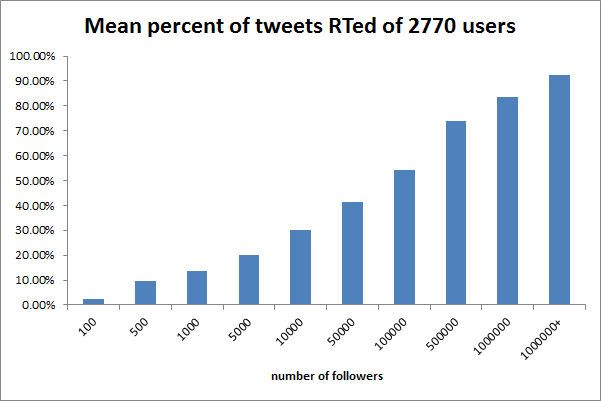
Our regression model helps fill in the blanks for the large majority of users with a spotty history of retweets.
Retweets are the Currency of Social
So, why retweets?
Well, whether you call them “shares” (Facebook), “repins” (Pinterest), or retweets, circulating someone else’s content to your network is a remarkable activity -- and pretty much universal across all social networks. It demonstrates a significant commitment to the originating content.
Moreover, retweets are a great proxy for other important data.
For example, as you might expect, the number of retweets a user gets correlates strongly with the number of @mentions that user receives, with a correlation of ~0.8.

Even more excitingly, a higher retweet rate is associated with more traffic to tweeted URLs. In fact, the retweet rate is a stronger predictor of clicks than follower count! The correlations are ~0.7 and ~0.45, respectively.
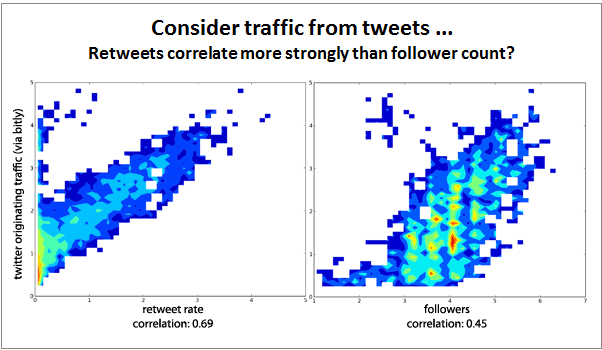
This comparison is perhaps not entirely fair: Twitter-originating traffic counts are hard to obtain in large quantities. So, we limit ourselves only to users who use bit.ly shortened links: perhaps not a totally representative sample. We also apply the same time discount to our traffic rate as we do to our retweet rate; this may heighten the correlation.
Still, it’s exciting to see that retweets are a great measure of traffic potential.
You might ask, “Why not just use traffic as the basis for Social Authority?” Well, while clicks might be your ultimate goal, that isn’t the same for everyone. Indeed, retweets represent a native measure of social success. That is, for many accounts, traffic isn’t the goal. Rather, the focus is on increased engagement and resonance of one’s social content. Retweets are a better social-specific metric.
(By the way, a good rule of thumb: consider a 10:1 ratio when it comes to clicks and retweets. That is, if a tweet gets 10 retweets, it’s probably garnering about 100 clicks. We’ll delve into this in a future blog post.)
What Does Social Authority Mean in Practice?
Do we add value beyond what’s already out there? That’s a good question. After all, follower count by itself is a great measure of influence. And it’s the challenge of any metric creator to offer something appreciably better.
Here, for example, we see that Klout scores correlate strongly with follower counts.
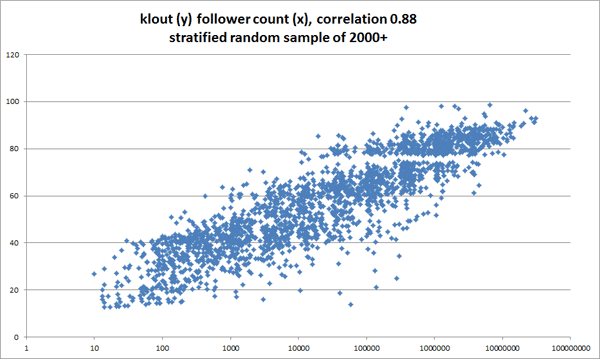
We aren’t picking on Klout. Social Authority has a similar relationship to follower count. Quite simply, people with lots of followers are generally more influential!
But we believe it’s the subtle re-ranking of a users that reveals the value of Social Authority versus follower count (or other metrics out there).
First, behold the most followed accounts on Twitter....
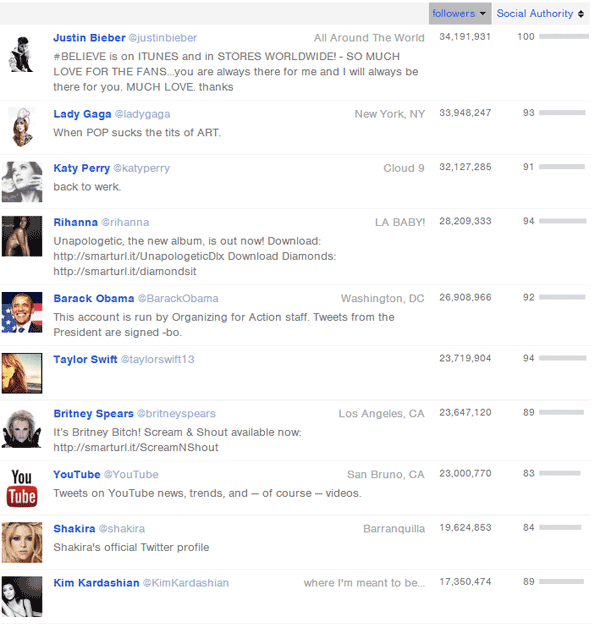
Now, we’re going to use Followerwonk to sort all active Twitter users and show you those with the highest Social Authority.

Yes, we also put Bieber on top! (Who doesn’t!?)
We’ve highlighted a number of accounts in red. Take a close look at these. We were initially surprised to see these accounts with high Social Authority so we went back and checked the data. Sure enough, these accounts get retweeted a lot. For example, @autocorrects is retweeted 7% more than @BarackObama, yet has 14 times fewer followers!
As you can see, Social Authority surfaces a completely different set of top users: those that are extremely effective in engaging their followers. Perhaps jump onto Twitter and look at their content. Expand their tweets: that’s where the magic is. Those in red often have a similar content strategy: short, pithy, often humorous, and targeted well to their audience.
This isn’t content that we necessarily like -- often, quite the opposite! Rather, these accounts have found the secret sauce: retweet bait. They’ve discovered content that gets their audiences’ attention, whether we like it or not, and prompts action in terms of retweets and traffic.
To us, at least, this is a revelation. We’ve always assumed that success on Twitter was largely about careful engagement, timely replies, and, sure, the occasional pithy remark. And that indeed may be a great strategy. But from the perspective of retweets (and clicks), engagement doesn’t matter at all. Many of these accounts never @mention anyone.
Social Authority is focused on content, versus users. When computing our metric, we don’t directly care how many followers a user has. Instead, our interest is in the content that she creates, and how it resonates with her audience. This is what sets Social Authority apart as a metric.
Let’s take a look at how you can leverage Social Authority right now.
Social Authority Use Case: Refining Your Engagement Strategy
One of the most effective uses of Twitter is to reach out to other people. That is, you want to leverage other people to retweet your content and spread your message to their audience.
Social Authority and the engagement metrics we released in December can help.
.png)
Simply, you want to find that sweet spot of users who are both influential, and also likely to respond to any engagement that you direct at them.
Step 1. Go to Followerwonk and do a bio search for keywords related to your industry. Limit the search to your followers. (Here’s an example.)
Step 2. Sort by Social Authority.
Step 3. Mouse over each user and find those with a high engagement rate. This will reveal possible candidates for direct engagement (DMs, @contacts, or even RTs of their content).
Here, for example, are the most influential followers of @followerwonk with “SEO” in their bio.
.png)
On mouse-over, I see that Rand has a really high engagement rate. Over 60% of his tweets are @mentions of other people! Notice that we have a bidirectional relationship (the little arrows): that is, he follows us, and we follow him. He’d be a great one to contact (if we weren’t already seeing him in the office pretty much everyday)!
Social Authority Use Case: Content Insights
Let’s say you’re thinking of opening a restaurant in the Bay Area. How can you use Twitter, and Social Authority, to help?
We can start by doing a comparison of the followers of three restaurant owners or Food writers.
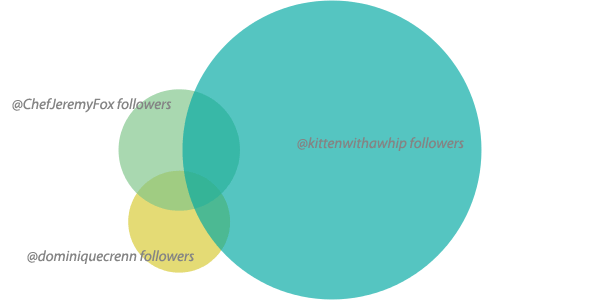
In this report, we see that there are ~400 who follow all of them. We can pop this list of users open and sort by Social Authority.
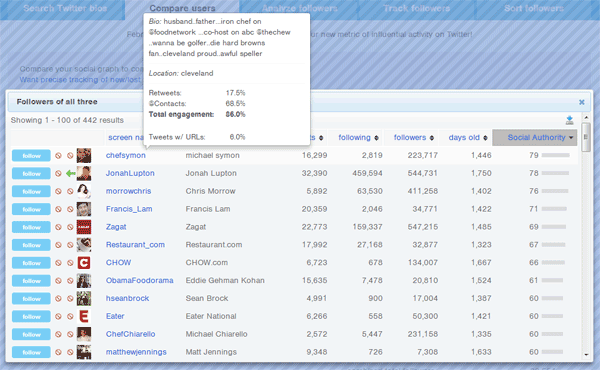
As we mouse-over each user, we discover their engagement rates. Note that @chefsymon, with the highest Social Authority in this list, has a rocking 86% engagement rate! Compare this to, say, Zagats with a mere 6.5% rate.
Which is the better choice to @engage in an attempt to attract their attention (and retweets)?
But there’s more we can do with this list then find potential brand amplifiers. Notice, for example, that @Francis_Lam, with a “mere” 34,000 followers has a great Social Authority score. It’s worth jumping into his tweet stream and looking carefully at his content.
What is it about his style that generates so many retweets? His frequent tweeting? His food-related one-liners?
While we will discuss content strategies in a later blog post, we believe that, to some extent, there are different content strategies for each industry. What works well for one audience, won’t work for others. So, carefully examining high Social Authority users -- particularly those who are outliers in terms of having relatively few followers -- is a great way to discover the content that ignites your audience.
We can take this one step further still. We can analyze @Francis_Lam’s followers.

Then, we can hone in those high Social Authority users local to us. Perhaps a special invite to a soft opening?
Bottom line
One of our core values at SEOmoz is transparency. As such, we’re against “mystery meat” metrics. We believe that metrics are only enhanced when you have real insight into what goes into them.
Social Authority is a tool for marketers to find key relationships and great content strategies. It’s backed by serious research and development.
We welcome your feedback, and look forward to seeing how you’ll take advantage of our score.



Comments
Please keep your comments TAGFEE by following the community etiquette
Comments are closed. Got a burning question? Head to our Q&A section to start a new conversation.